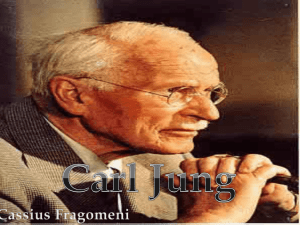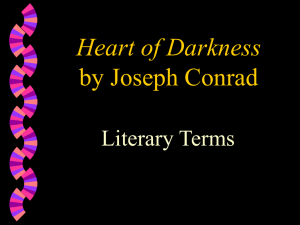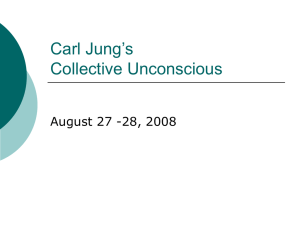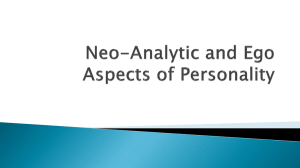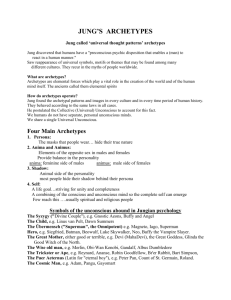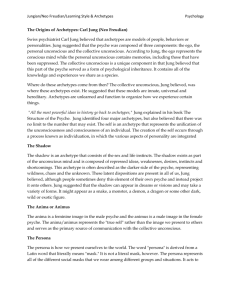The Archetypes and the Collective Unconscious
advertisement
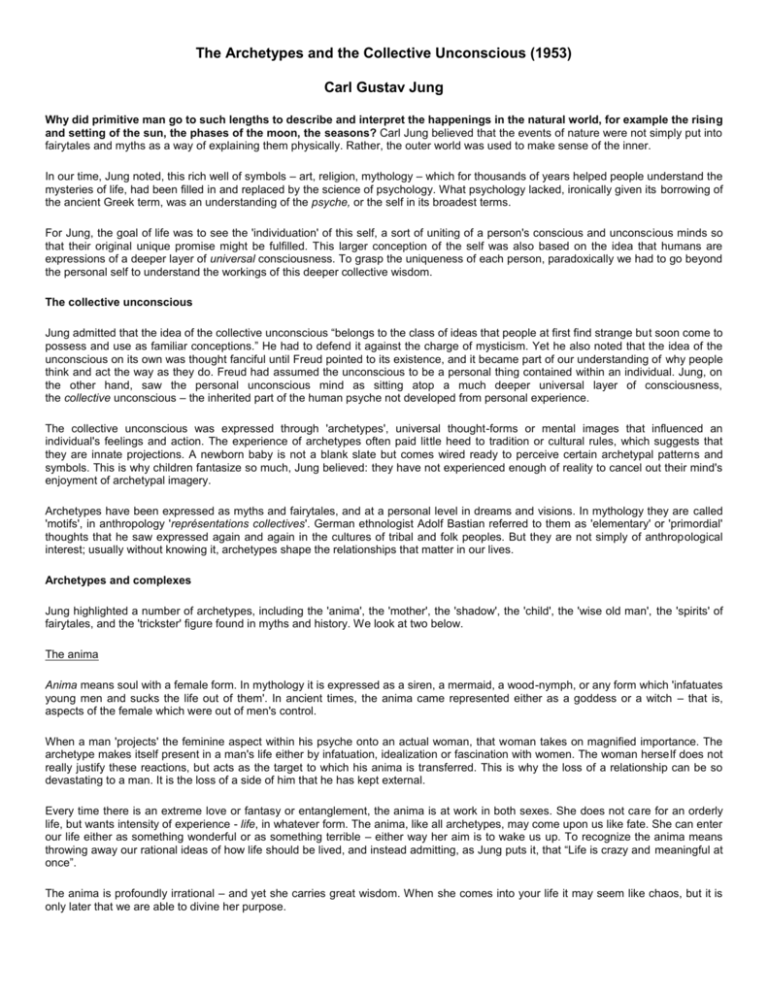
The Archetypes and the Collective Unconscious (1953) Carl Gustav Jung Why did primitive man go to such lengths to describe and interpret the happenings in the natural world, for example the rising and setting of the sun, the phases of the moon, the seasons? Carl Jung believed that the events of nature were not simply put into fairytales and myths as a way of explaining them physically. Rather, the outer world was used to make sense of the inner. In our time, Jung noted, this rich well of symbols – art, religion, mythology – which for thousands of years helped people understand the mysteries of life, had been filled in and replaced by the science of psychology. What psychology lacked, ironically given its borrowing of the ancient Greek term, was an understanding of the psyche, or the self in its broadest terms. For Jung, the goal of life was to see the 'individuation' of this self, a sort of uniting of a person's conscious and unconscious minds so that their original unique promise might be fulfilled. This larger conception of the self was also based on the idea that humans are expressions of a deeper layer of universal consciousness. To grasp the uniqueness of each person, paradoxically we had to go beyond the personal self to understand the workings of this deeper collective wisdom. The collective unconscious Jung admitted that the idea of the collective unconscious “belongs to the class of ideas that people at first find strange but soon come to possess and use as familiar conceptions.” He had to defend it against the charge of mysticism. Yet he also noted that the idea of the unconscious on its own was thought fanciful until Freud pointed to its existence, and it became part of our understanding of why people think and act the way as they do. Freud had assumed the unconscious to be a personal thing contained within an individual. Jung, on the other hand, saw the personal unconscious mind as sitting atop a much deeper universal layer of consciousness, the collective unconscious – the inherited part of the human psyche not developed from personal experience. The collective unconscious was expressed through 'archetypes', universal thought-forms or mental images that influenced an individual's feelings and action. The experience of archetypes often paid little heed to tradition or cultural rules, which suggests that they are innate projections. A newborn baby is not a blank slate but comes wired ready to perceive certain archetypal patterns and symbols. This is why children fantasize so much, Jung believed: they have not experienced enough of reality to cancel out their mind's enjoyment of archetypal imagery. Archetypes have been expressed as myths and fairytales, and at a personal level in dreams and visions. In mythology they are called 'motifs', in anthropology 'représentations collectives'. German ethnologist Adolf Bastian referred to them as 'elementary' or 'primordial' thoughts that he saw expressed again and again in the cultures of tribal and folk peoples. But they are not simply of anthropological interest; usually without knowing it, archetypes shape the relationships that matter in our lives. Archetypes and complexes Jung highlighted a number of archetypes, including the 'anima', the 'mother', the 'shadow', the 'child', the 'wise old man', the 'spirits' of fairytales, and the 'trickster' figure found in myths and history. We look at two below. The anima Anima means soul with a female form. In mythology it is expressed as a siren, a mermaid, a wood-nymph, or any form which 'infatuates young men and sucks the life out of them'. In ancient times, the anima came represented either as a goddess or a witch – that is, aspects of the female which were out of men's control. When a man 'projects' the feminine aspect within his psyche onto an actual woman, that woman takes on magnified importance. The archetype makes itself present in a man's life either by infatuation, idealization or fascination with women. The woman herself does not really justify these reactions, but acts as the target to which his anima is transferred. This is why the loss of a relationship can be so devastating to a man. It is the loss of a side of him that he has kept external. Every time there is an extreme love or fantasy or entanglement, the anima is at work in both sexes. She does not care for an orderly life, but wants intensity of experience - life, in whatever form. The anima, like all archetypes, may come upon us like fate. She can enter our life either as something wonderful or as something terrible – either way her aim is to wake us up. To recognize the anima means throwing away our rational ideas of how life should be lived, and instead admitting, as Jung puts it, that “Life is crazy and meaningful at once”. The anima is profoundly irrational – and yet she carries great wisdom. When she comes into your life it may seem like chaos, but it is only later that we are able to divine her purpose. The Mother The Mother archetype takes the form of personal mother, grandmother, stepmother, mother in law, nurse, governess. It can be fulfilled in figurative Mothers such as Mary Mother of God, Sophia, or the Mother who becomes a maiden again in the myth of Demeter and Kore. Other Mother symbols include the Church, country, the Earth, the woods, the sea, a garden, a ploughed field, a spring or well. The positive aspect of the archetype is Motherly love and warmth, so celebrated in art and poetry, which gives us our first identity in the world. Yet it can have negative meaning – the loving mother or the terrible mother or goddess of fate. Jung considered the Mother the most important archetype because it seemed to contain all else. When there is an imbalance of the archetype in a person, we see the Mother 'complex'. In men, the complex may give rise to 'Don Juanism', which can make a man fixated on pleasing all women. Yet a man with a mother complex may also have a revolutionary spirit: tough, persevering, extremely ambitious. In women, the complex can result in an exaggeration of the maternal instinct, with a woman living for her children, sacrificing her individuality. Her husband becomes just part of the furniture. Men may be initially attracted to women with a mother complex because they are the picture of femininity and innocence. Yet they are also screens onto which a man can project or externalize his anima, and he only later discovers the real woman he has married. In other forms of the archetype, a woman will go to any lengths to not be like her biological mother. She may carve out a sphere of her own, for example becoming an intellectual to show up her mother's lack of education. A choice of marriage partner may be to antagonize and move away from the mother. Other women in the hold of the archetype may have an unconscious incestuous relationship with the biological father and jealousy of the mother. They may become interested in married men or having romantic adventures. **** Jung noted that in evolutionary terms the unconscious came well before the development conscious thought. Yet in its youthful enthusiasm the conscious mind feels it can defy or deny its deeper counterpart; it is all-powerful while the unconscious seems a murky irrelevance. Yet he believed that “Man's worst sin is unconsciousness”. We project everything we internally don't like or can't accept onto the world, so that we wage war instead of studying ourselves. It is a case of 'anything but self-knowledge' – but in the end we pay the price, whether as individuals or collectively. Spiritual archetypes Why is psychology as a science so young? Jung suggests it was because for most of human history it simply wasn't necessary. The wonderful imagery and mythology of religions was able to express the eternal archetypes perfectly. People feel a need to dwell upon ideas and images relating to rebirth and transformation, and religions supply these in abundance for every aspect of the psyche. The Catholic Church's strange ideas of the Virgin Birth and the Trinity are not fanciful images but packed with meaning, Jung wrote, archetypes of protection and healing that administered to any ruptures in the minds of the faithful. The Protestant Reformation reacted against all this. The rich Catholic imagery and dogma became nothing but 'superstition', and in Jung's view this attitude made way for the barrenness of contemporary life. Genuine spirituality must engage both the unconscious and the conscious mind, the depths as well as the heights. Jung observed the trend of people in the West flocking to Eastern spirituality, but felt this was hardly necessary given the depth of meaning embedded in the Christian tradition. Another result was that that people are attracted to political and social ideas that were “distinguished by their spiritual bleakness”. Humans have a religious instinct, Jung believed, whether it is a belief in God or in some secular faith like communism or atheism. “No one can escape the prejudice of being human” he observed. Individuation 'Individuation' was Jung's term for the point when a person is finally able to integrate the opposites within them - their conscious and unconscious minds. Individuation simply means to become what you always were in potentia, to fulfil your unique promise. The result is an individual in the real sense of the word, a whole and indestructible self that can no longer be hijacked by splintered aspects or complexes. But this reintegration does not happen by thinking about it rationally. It is a journey with unexpected twists and turns. Many myths show how we need to follow a path that transcends reason in order to fulfill ourselves in life. Jung went to some length to define the self. He understood it to be something different from the ego; in fact the self-incorporated the ego, “just as a large circle encloses a smaller one”. While the ego relates to the conscious mind, the self belongs to the personal and collective unconscious. The healing mandala Jung included in Archetypes and the Collective Unconscious many reproductions of mandalas, abstract patterned images whose name in Sanskrit means 'circle'. He believed that when a person draws or paints a mandala, unconscious leanings or wants are expressed in its patterns, symbols and shapes. In his therapeutic practice, Jung found mandalas to have a 'magical' effect, reducing confusion in the psyche to order, and often affecting a person in ways that only became apparent later. They worked because the unconscious is allowed free reign; what has been swept under comes to the surface. Motifs such as egg shapes, a lotus flower, a star or sun, a snake, castles, cities, eyes, etc. are produced for no obvious reason, yet reflect or draw out processes that are going on deep below that person's conscious thinking. When a person became able to make a meaningful interpretation of the images, Jung observed that it was usually the beginning of psychological healing. It was one step taken in the individuation process. Final comments We think we are modern and civilized with all our technology and knowledge, but inside, Jung says, we are still 'primitives'. He once observed in Switzerland a Strudel, a local witch-doctor, remove a spell from a stable – in the shadow of a railway line on which several trans-European expresses roared by. Modernity does not do away with the need for us to attend to our unconscious minds. If we do neglect this side of us, the archetypes simply look for new forms of expression, in the process derailing our carefully made plans. Usually the unconscious supports our conscious decisions, but when a gap appears the archetypes are expressed in strange and powerful ways; we can be ambushed by lack of self-knowledge. The universe of ancient symbols we once used for deciphering life's changes and larger meaning has been replaced by a science – psychology - that was never designed to understand the soul and cater to it. Writing of the scientific mindset in general, Jung wrote: “Heaven has become for us the cosmic space of the physicists...But 'the heart glows,' and a secret unrest gnaws at the roots of our being.” Modern man or woman lives with a spiritual emptiness that was once easily filled by religion or mythology. Only a new type of psychology that actually recognized the depth of the psyche would be able to quell this secret unrest. When it seems you are helpless in the face of problems, it should be remembered that this deeper mind carries the totality of human experience, a vast store of objective wisdom and perfect solutions. It only has to be recognized and accessed. Source:50 Psychology Classics: Who We Are, How We Think, What We Do. Insight and inspiration from 50 key books(Nicholas Brealey, London & Boston), Tom Butler-Bowdon.
